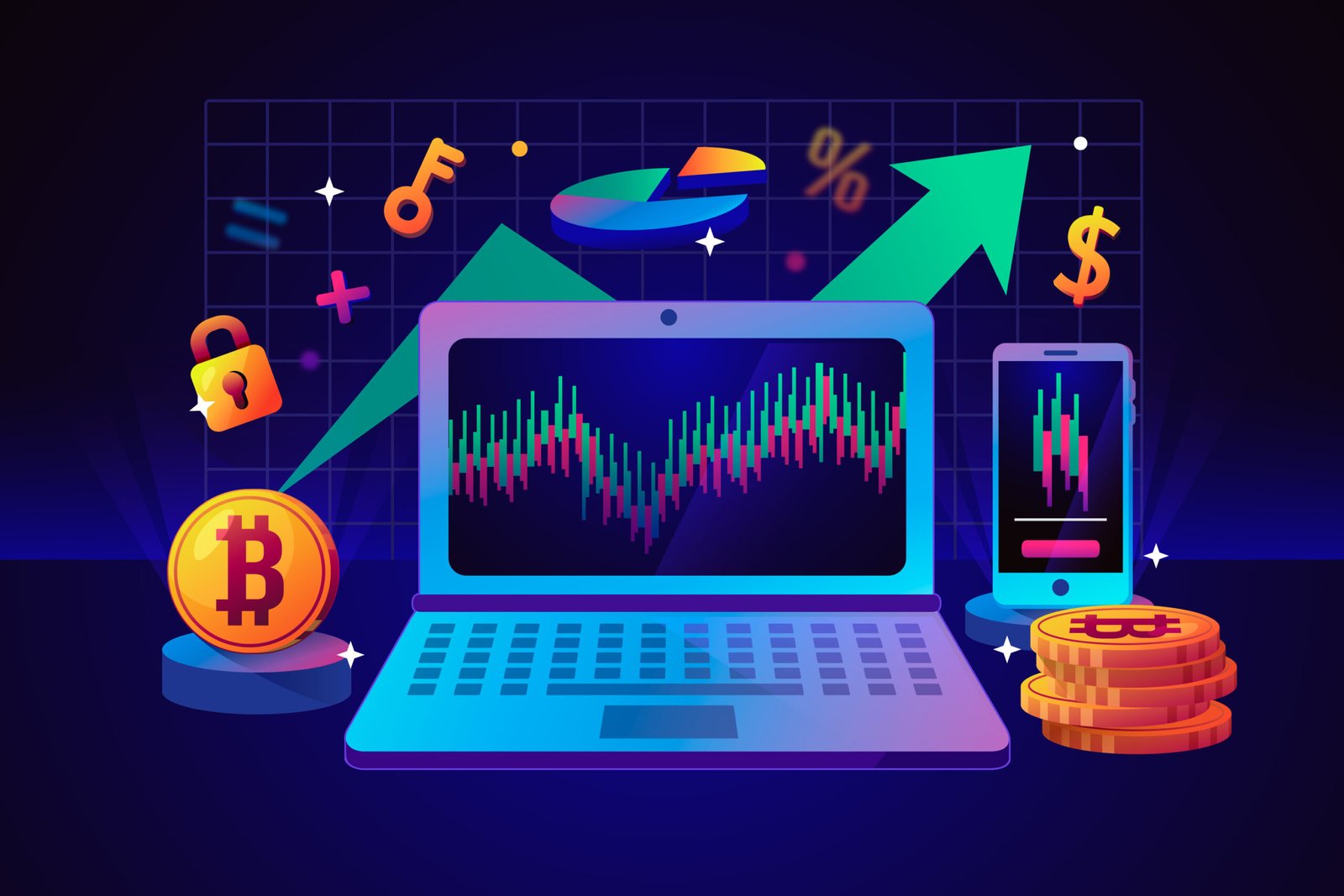In a world where the financial landscape is constantly evolving, digital assets are garnering significant attention. And with this rise in interest comes the emergence of a powerful financial instrument: crypto futures. These innovative derivatives contracts enable investors to speculate on the future price of cryptocurrencies, opening up a world of possibilities. In this article, we will delve into the realm of crypto futures and explore how they are unlocking the potential of digital assets. From their historical roots to their current significance in the market, we will navigate through the intricacies and advantages of this increasingly popular investment tool. As the adoption of cryptocurrencies continues to grow, crypto futures offer a unique opportunity for both institutional and individual investors to manage risk, hedge positions, and profit from the volatility of the digital asset market. With their ability to amplify gains and losses, understanding how to effectively trade crypto futures can be a game-changer for investors seeking to maximize their returns. Join us as we explore the rise of crypto futures and the endless possibilities they bring to the world of digital assets.
Introduction to Crypto Futures
What Are Crypto Futures?
Crypto futures are derivative financial contracts that enable traders to buy or sell a cryptocurrency at a predetermined price on a specific future date. Unlike traditional spot trading, where cryptocurrencies are bought or sold for immediate delivery, futures contracts focus on the agreement to trade the cryptocurrency at a future date and price, providing a way to speculate on price movements without the need for actual ownership of the underlying asset.
In a crypto futures contract, two parties agree on a price for a particular cryptocurrency, such as Bitcoin or Ethereum, with the transaction set to occur at a future date. This mechanism allows traders to profit from anticipated price changes without having to directly hold the cryptocurrency. The value of the futures contract fluctuates based on the underlying cryptocurrency’s market price, providing opportunities for profit or loss.
How Crypto Futures Work
- Contract Specification: Each crypto futures contract specifies the amount of cryptocurrency to be traded, the price at which it will be traded, and the expiration date when the contract settles.
- Leverage and Margin: Futures trading often involves leverage, allowing traders to control larger positions with a relatively small amount of capital. For instance, a 10x leverage means a trader can enter a $10,000 position with only $1,000. Margin is the collateral required to maintain a futures position.
- Profit and Loss Calculation: Profit or loss is determined by the difference between the agreed-upon contract price and the market price at the time of contract settlement. If the market price is higher than the contract price at settlement, the buyer profits, and the seller incurs a loss. Conversely, if the market price is lower, the seller profits, and the buyer incurs a loss.
- Settlement: Settlement can occur in two ways: physical delivery or cash settlement. Physical delivery involves the actual exchange of the cryptocurrency, while cash settlement involves the transfer of the equivalent cash value.
Example of a Crypto Futures Trade
Suppose a trader believes that the price of Bitcoin will rise from its current level of $30,000 to $35,000 in the next three months. They decide to enter into a futures contract agreeing to buy Bitcoin at $32,000 three months from now. If, at the contract’s expiration, Bitcoin’s price is indeed $35,000, the trader profits $3,000 per Bitcoin. However, if the price drops to $28,000, the trader incurs a $4,000 loss per Bitcoin.
Historical Context and Evolution
Early Beginnings
The concept of futures trading has a long history, with its origins tracing back to ancient agricultural markets. Farmers and merchants would agree on future prices for crops, helping to stabilize incomes and manage risks related to price fluctuations and supply uncertainties. This practice evolved over centuries, eventually formalizing into structured futures markets.
Emergence of Financial Futures
The modern futures market took shape in the 19th and 20th centuries with the establishment of exchanges like the Chicago Board of Trade (CBOT) and the Chicago Mercantile Exchange (CME). These exchanges standardized futures contracts for commodities such as grains, metals, and livestock. In the latter half of the 20th century, financial futures, including contracts for currencies, interest rates, and stock indices, were introduced, expanding the range of assets that could be traded through futures.
- Sponsored -

Introduction of Crypto Futures
Crypto futures were introduced in the mid-2010s as the cryptocurrency market began to gain traction. The launch of Bitcoin futures by the CME and Cboe Global Markets in 2017 was a pivotal moment, marking the entry of cryptocurrencies into mainstream financial markets. These products provided a regulated framework for investors to gain exposure to Bitcoin’s price movements without needing to hold the underlying asset. The introduction of Ethereum and other altcoin futures followed, broadening the scope of crypto futures trading.
Adoption and Growth
Since their introduction, crypto futures have experienced rapid growth, driven by increasing interest from retail and institutional investors. The market has expanded to include various cryptocurrencies and derivatives, offering more sophisticated trading tools and options. Major cryptocurrency exchanges, such as Binance, BitMEX, and FTX, have developed their own futures platforms, catering to the growing demand for crypto futures trading.
The adoption of crypto futures has also been fueled by the rising acceptance of cryptocurrencies as legitimate financial assets. Regulatory developments and the integration of traditional financial institutions into the crypto space have further legitimized and expanded the market for crypto futures.
Importance in the Financial Ecosystem
Providing Liquidity
Crypto futures contribute significantly to market liquidity, ensuring that there are enough buyers and sellers to facilitate smooth trading. This liquidity is crucial for maintaining stable prices and reducing the volatility typically associated with cryptocurrencies. By attracting a diverse range of participants, including speculators, hedgers, and market makers, crypto futures enhance the overall depth and efficiency of the market.
Enabling Price Discovery
Futures markets play a key role in price discovery, the process of determining the fair market value of an asset based on supply and demand dynamics. The prices of crypto futures contracts reflect market participants’ expectations about the future value of the underlying cryptocurrency. This helps establish benchmark prices and provides valuable information to traders and investors, contributing to more informed decision-making.
Offering Hedging Opportunities
Crypto futures provide an effective mechanism for hedging against price risks. For example, a Bitcoin miner might use futures contracts to lock in a selling price for Bitcoin to protect against potential price declines. Similarly, investors with significant cryptocurrency holdings can use futures to hedge against adverse price movements, mitigating potential losses and stabilizing their investment portfolios.
Attracting Institutional Participation
The introduction of regulated crypto futures products has made the cryptocurrency market more accessible to institutional investors. These products offer a familiar and compliant way for institutions to gain exposure to cryptocurrencies, driving further adoption and growth. The participation of institutional players brings additional liquidity, stability, and legitimacy to the crypto futures market.
Enhancing Market Efficiency
Crypto futures contribute to market efficiency by facilitating arbitrage opportunities and enabling more sophisticated trading strategies. Arbitrageurs can exploit price differences between futures and spot markets, helping to align prices and reduce discrepancies. The availability of futures contracts also allows for complex strategies, such as spread trading and options combinations, enhancing the overall functionality and efficiency of the market.
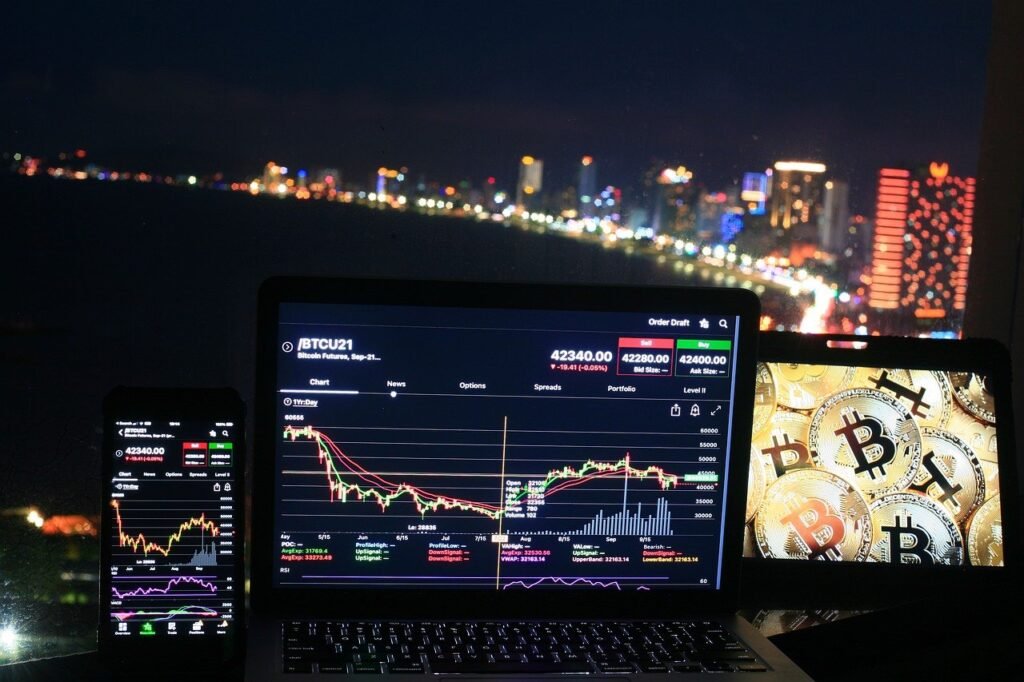
Understanding Digital Assets
Digital assets represent a broad category of value or contractual rights stored and transferred electronically. They have transformed the financial landscape, providing new ways to store value, execute transactions, and create innovative applications. This section delves into the definition, types, key characteristics, and the role of blockchain technology in digital assets.
Definition and Types of Digital Assets
Digital assets are electronic representations of value or ownership that can be transferred and stored digitally. They encompass a variety of forms, from cryptocurrencies to tokens used in decentralized applications. Key types include:
- Cryptocurrencies: These are digital or virtual currencies that use cryptography for security. Examples include Bitcoin (BTC), Ethereum (ETH), and Litecoin (LTC). They function as a medium of exchange and are often decentralized, relying on blockchain technology to record transactions and manage the issuance of new units.
- Stablecoins: Stablecoins are a type of cryptocurrency designed to maintain a stable value relative to a specific asset or basket of assets, such as the US dollar or gold. Examples include Tether (USDT), USD Coin (USDC), and DAI. Stablecoins aim to combine the benefits of cryptocurrencies (speed, low cost, security) with the stability of traditional fiat currencies.
- Utility Tokens: These tokens provide access to a product or service within a particular platform or ecosystem. They are often used to raise funds for blockchain projects through Initial Coin Offerings (ICOs) or Token Generation Events (TGEs). Examples include Basic Attention Token (BAT) for digital advertising and Chainlink (LINK) for decentralized oracles.
- Security Tokens: Security tokens represent ownership in a real-world asset, such as stocks, real estate, or bonds. They are subject to securities regulations and provide investors with rights such as dividends or profit sharing. Examples include tZERO (TZROP) and Securitize’s DS Protocol tokens.
- Non-Fungible Tokens (NFTs): NFTs are unique digital assets that represent ownership of a specific item, such as art, collectibles, or in-game items. Unlike cryptocurrencies, which are interchangeable, NFTs are one-of-a-kind and cannot be exchanged on a one-to-one basis. Examples include CryptoPunks and Bored Ape Yacht Club.
- Decentralized Finance (DeFi) Tokens: DeFi tokens are used within decentralized financial applications to provide services like lending, borrowing, and trading without intermediaries. Examples include Uniswap (UNI), Aave (AAVE), and Compound (COMP).
Key Characteristics of Digital Assets
Digital assets exhibit several defining characteristics that set them apart from traditional financial instruments:
- Decentralization: Many digital assets operate on decentralized networks, meaning they are not controlled by any single entity. This decentralization is achieved through blockchain technology, where consensus mechanisms (like proof of work or proof of stake) validate and record transactions across a distributed ledger.
- Transparency: Transactions involving digital assets are typically recorded on public ledgers (blockchains), making them visible and verifiable by anyone. This transparency enhances trust and reduces the need for intermediaries.
- Immutability: Once a transaction is recorded on a blockchain, it cannot be altered or deleted. This immutability ensures the integrity of the data and provides a reliable historical record.
- Divisibility: Digital assets can often be divided into smaller units. For instance, Bitcoin can be divided into satoshis (1 Bitcoin = 100 million satoshis), allowing for microtransactions and greater flexibility in usage.
- Programmability: Many digital assets, particularly those based on smart contracts, are programmable. This means they can automatically execute predefined actions based on certain conditions, enabling complex financial transactions and decentralized applications.
- Borderless and Accessible: Digital assets are not confined by geographic boundaries and can be accessed by anyone with an internet connection. This global accessibility enables inclusive financial participation and opens up new markets.
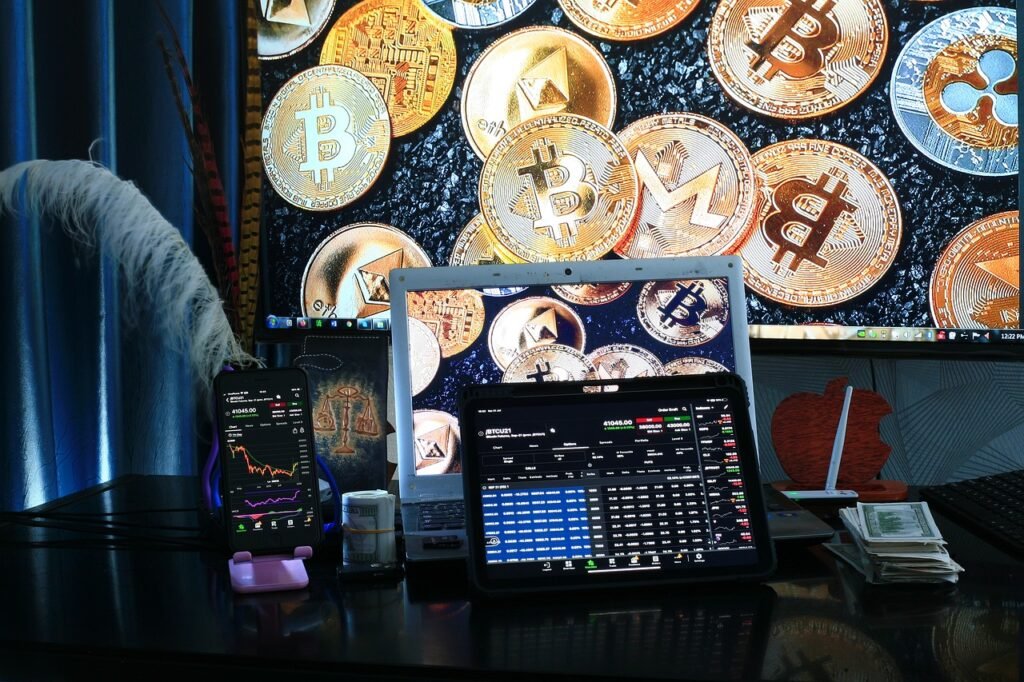
Role of Blockchain Technology
Blockchain technology is the backbone of most digital assets, providing the infrastructure that enables their operation and security. Here’s how blockchain technology underpins digital assets:
Decentralized Ledger
A blockchain is a decentralized, distributed ledger that records transactions across a network of computers. Each block in the chain contains a list of transactions, and these blocks are linked together in chronological order. This structure ensures that once a transaction is recorded, it cannot be altered without altering all subsequent blocks, which would require consensus from the majority of the network.
Consensus Mechanisms
Consensus mechanisms are protocols used to achieve agreement on the state of the blockchain among distributed nodes. Common consensus mechanisms include:
- Proof of Work (PoW): Used by Bitcoin, PoW requires network participants (miners) to solve complex mathematical problems to validate transactions and create new blocks. This process is energy-intensive but secures the network against attacks.
- Proof of Stake (PoS): PoS, used by Ethereum 2.0 and other networks, relies on validators who hold and stake a certain amount of cryptocurrency to propose and validate blocks. This method is more energy-efficient than PoW and reduces the risk of centralization.
- Delegated Proof of Stake (DPoS): DPoS involves a voting system where stakeholders elect a small number of delegates to validate transactions and create new blocks. This method increases efficiency and scalability but introduces a level of centralization.
Smart Contracts
Smart contracts are self-executing contracts with the terms directly written into code. They automatically execute and enforce agreements when predefined conditions are met, eliminating the need for intermediaries. Smart contracts enable a wide range of applications, from simple token transfers to complex decentralized financial products.
Security and Trust
Blockchain technology provides robust security through cryptographic techniques. Each transaction is encrypted and linked to previous transactions, making it nearly impossible to alter the data without detection. This security framework builds trust among participants, as they can rely on the integrity and accuracy of the blockchain.
Scalability and Interoperability
Blockchain networks are continuously evolving to address challenges related to scalability and interoperability. Solutions like sharding (splitting the blockchain into smaller segments) and cross-chain protocols (facilitating interaction between different blockchains) are being developed to enhance performance and connectivity.
Advantages of Digital Assets
Digital assets offer several advantages over traditional financial instruments:
- Efficiency: Transactions involving digital assets can be executed quickly and at lower costs compared to traditional methods, reducing reliance on intermediaries and streamlining processes.
- Innovation: The programmability of digital assets enables the creation of new financial products and services, fostering innovation in areas like decentralized finance (DeFi), gaming, and digital art.
- Ownership and Control: Digital assets provide individuals with direct ownership and control over their assets, reducing the need for custodians and intermediaries.
- Inclusion: Digital assets can facilitate financial inclusion by providing access to financial services for unbanked and underbanked populations, leveraging the global reach of blockchain technology.
- Transparency and Trust: The transparent nature of blockchain transactions enhances trust among participants and reduces the potential for fraud and corruption.
Challenges and Considerations
Despite their advantages, digital assets also present challenges and considerations:
- Regulatory Uncertainty: The regulatory landscape for digital assets is still evolving, with varying approaches across different jurisdictions. Compliance with local regulations is essential to avoid legal risks.
- Security Risks: While blockchain technology provides strong security, digital assets are still susceptible to hacking, phishing, and other cyber threats. Users must take precautions to secure their wallets and private keys.
- Volatility: Many digital assets, particularly cryptocurrencies, are highly volatile, leading to significant price fluctuations that can impact investment and trading decisions.
- Scalability Issues: Some blockchain networks face challenges related to scalability, leading to slower transaction speeds and higher fees during periods of high demand.
- Interoperability: The lack of interoperability between different blockchain networks can limit the seamless transfer of assets and data across platforms.
The Basics of Futures Trading
Futures trading is a cornerstone of modern financial markets, offering a way to hedge against price fluctuations and speculate on asset values. With its roots in traditional commodities trading, futures trading has expanded to include a wide range of assets, including cryptocurrencies. Understanding the fundamentals of futures trading is crucial for anyone looking to participate in this dynamic and potentially profitable market.
What Is Futures Trading?
Futures trading involves buying or selling a futures contract, which is an agreement to purchase or sell an asset at a predetermined price on a specific date in the future. Unlike spot trading, where the exchange of the asset happens immediately, futures contracts specify future delivery dates, allowing traders to speculate on the future price movements of the asset without owning it directly.
Key Elements of a Futures Contract:
- Underlying Asset: This is the asset that the futures contract is based on. It can be a commodity (like gold or oil), a financial instrument (like stock indices or currencies), or a cryptocurrency (like Bitcoin or Ethereum).
- Contract Size: This specifies the quantity of the underlying asset covered by the contract. For example, a futures contract for 5 Bitcoins means the trader is agreeing to buy or sell 5 Bitcoins at the contract’s expiration.
- Expiration Date: This is the date when the contract is settled. At this point, the buyer and seller are obligated to complete the transaction according to the contract terms, either through physical delivery or cash settlement.
- Price: The agreed-upon price at which the asset will be bought or sold on the expiration date. This price is determined when the contract is created.
How Futures Trading Works
Step-by-Step Process:
- Opening a Position: A trader opens a position by buying (going long) or selling (going short) a futures contract. Going long means buying a contract with the expectation that the asset’s price will rise. Going short means selling a contract with the expectation that the asset’s price will fall.
- Leverage and Margin: Futures trading often involves leverage, which allows traders to control a large position with a relatively small initial investment. Margin is the collateral required to maintain a position. It includes initial margin (the upfront deposit) and maintenance margin (the minimum balance required to keep the position open).
- Daily Settlement: Futures contracts are marked-to-market daily. This means the gains or losses from the day’s price changes are calculated and reflected in the trader’s account balance. This daily settlement process ensures that traders have sufficient margin to cover potential losses.
- Closing a Position: A position can be closed before the expiration date by taking an opposite position in the same contract. For instance, if a trader has bought a futures contract, they can close the position by selling an identical contract. This offsets the position, realizing any profit or loss.
- Settlement: At the expiration date, the contract is settled. Depending on the contract, settlement can occur through physical delivery of the asset or cash settlement, where the difference between the contract price and the market price is paid in cash.
Types of Futures Contracts
1. Commodity Futures: These contracts involve physical goods like agricultural products (wheat, corn), metals (gold, silver), and energy (oil, natural gas). They are used by producers and consumers to hedge against price changes and by speculators to profit from market movements.
2. Financial Futures: These include contracts based on financial instruments such as stock indices (S&P 500, Nasdaq), interest rates (U.S. Treasury bonds), and currencies (EUR/USD). They are popular among institutional investors for managing portfolio risk and among traders for speculating on financial markets.
3. Cryptocurrency Futures: These contracts are based on digital assets like Bitcoin, Ethereum, and other cryptocurrencies. They offer a way to speculate on the volatile crypto market without owning the underlying coins and are traded on specialized exchanges.
Also Read: A Comprehensive Guide to Understanding Crypto Staking: Everything You Need to Know
Key Participants in Futures Markets
1. Hedgers: Hedgers use futures contracts to protect against price changes in the underlying asset. For example, a farmer might sell futures contracts to lock in a price for their crops, ensuring stable income despite potential market fluctuations. Similarly, a cryptocurrency miner might use futures to secure a favorable price for their mined coins.
2. Speculators: Speculators aim to profit from price movements by buying and selling futures contracts based on market predictions. They do not have a direct interest in the underlying asset but seek to capitalize on volatility. Their activities add liquidity to the market and can influence price trends.
3. Arbitrageurs: Arbitrageurs exploit price discrepancies between different markets or contract maturities. For instance, they might buy a futures contract in one market and sell it in another where the price is higher, profiting from the difference. This helps to align prices across markets and maintain market efficiency.
4. Market Makers: Market makers provide liquidity by continuously offering to buy and sell futures contracts. They facilitate smooth trading and narrow the bid-ask spread, making it easier for other participants to enter and exit positions.
Advantages of Futures Trading
1. Leverage: Futures trading allows traders to control large positions with a relatively small amount of capital, amplifying potential returns. However, it also increases risk, as losses can exceed the initial investment.
2. Hedging: Futures contracts provide a mechanism for hedging against price volatility. This is valuable for producers, consumers, and investors looking to stabilize income or manage risk.
3. Liquidity: Futures markets are typically very liquid, with high trading volumes and tight bid-ask spreads. This liquidity facilitates quick and efficient trade execution.
4. Diverse Markets: Futures contracts are available for a wide range of assets, including commodities, financial instruments, and cryptocurrencies. This diversity offers opportunities to trade various markets and develop complex strategies.
5. Price Discovery: Futures markets play a crucial role in price discovery, reflecting market participants’ expectations about future price movements. This helps to establish benchmark prices and informs trading decisions.
Risks and Considerations in Futures Trading
1. Leverage Risks: While leverage can amplify gains, it also magnifies losses. Traders must carefully manage their margin and be prepared for potential losses that can exceed their initial investment.
2. Market Volatility: Futures prices can be highly volatile, leading to rapid and significant price swings. Traders must stay informed about market conditions and be ready to adapt their strategies.
3. Margin Calls: If a trader’s account balance falls below the maintenance margin, they may receive a margin call, requiring them to deposit additional funds to maintain their position. Failure to meet a margin call can result in forced liquidation of the position.
4. Liquidity Risk: While futures markets are generally liquid, there can be periods of low liquidity or wide bid-ask spreads, making it difficult to enter or exit positions at favorable prices.
5. Regulatory and Operational Risks: Futures trading is subject to regulatory oversight, and changes in regulations can impact trading conditions. Additionally, operational risks, such as technical issues on trading platforms, can affect trade execution and account management.
Getting Started with Futures Trading
1. Education and Research: Before entering the futures market, it’s essential to understand the fundamentals, including contract specifications, trading strategies, and risk management techniques. Resources such as online courses, webinars, and trading simulators can be valuable.
2. Choosing a Broker: Select a reputable broker or trading platform that offers access to the futures markets you’re interested in. Consider factors such as fees, margin requirements, trading tools, and customer support.
3. Developing a Strategy: Define your trading goals and develop a strategy that aligns with your risk tolerance and market outlook. This may include technical analysis, fundamental analysis, or a combination of both.
4. Practicing Risk Management: Implement risk management techniques, such as setting stop-loss orders, diversifying your portfolio, and monitoring your margin levels. Regularly review and adjust your strategy based on market conditions and performance.
5. Monitoring the Market: Stay informed about market trends, news, and events that can impact futures prices. Use trading tools and analytics to track market movements and identify trading opportunities.
Futures trading offers a versatile and dynamic way to engage with various financial markets, from commodities and financial instruments to the burgeoning world of cryptocurrencies. By understanding the basics and developing a solid trading strategy, you can navigate the complexities of futures trading and potentially unlock significant opportunities for profit and risk management.
Advantages of Trading Crypto Futures
Crypto futures trading has revolutionized the way investors interact with the cryptocurrency market, offering a range of advantages that appeal to both novice and seasoned traders. By combining the benefits of traditional futures with the dynamic nature of digital assets, crypto futures provide a versatile and powerful tool for maximizing returns, managing risk, and gaining market exposure. Here, we explore the key advantages of trading crypto futures and why they have become a popular choice for investors.
1. Leverage: Amplifying Potential Returns
Leverage is one of the most compelling features of crypto futures trading. It allows traders to control a large position with a relatively small amount of capital, significantly amplifying potential returns.
- Example: With a leverage ratio of 10:1, a $1,000 investment can control a $10,000 position. If the underlying cryptocurrency’s price moves favorably, the gains on the leveraged position can be substantial compared to a spot investment.
Benefits of Leverage:
- Increased Profit Potential: Small price movements can yield significant profits, making leverage a powerful tool for traders looking to maximize returns on their capital.
- Capital Efficiency: Traders can achieve higher exposure to the market without committing large amounts of capital, allowing for more flexible investment strategies.
Caution: While leverage can enhance profits, it also magnifies losses. Effective risk management strategies, such as setting stop-loss orders, are essential to mitigate potential downsides.
2. Hedging Against Market Volatility
Crypto futures provide an effective way to hedge against the notorious volatility of cryptocurrency markets. By locking in prices through futures contracts, traders and investors can protect their portfolios from adverse price movements.
- Long Hedge: If you own Bitcoin and anticipate a price drop, selling Bitcoin futures can lock in a selling price, offsetting potential losses in the spot market.
- Short Hedge: If you plan to buy Bitcoin and worry about price increases, buying Bitcoin futures can secure a buying price, countering the higher costs in the spot market.
Benefits of Hedging:
- Risk Management: Futures contracts help manage price risk, providing stability and predictability in income or costs.
- Portfolio Protection: Investors can safeguard their cryptocurrency holdings or planned acquisitions from market volatility, ensuring financial goals are met without the impact of sudden price changes.
3. Access to Both Long and Short Positions
Crypto futures trading offers the flexibility to take both long and short positions, enabling traders to profit from both rising and falling markets.
- Long Position: Buying a futures contract (going long) means you profit if the price of the cryptocurrency rises.
- Short Position: Selling a futures contract (going short) means you profit if the price of the cryptocurrency falls.
Benefits of Long and Short Positions:
- Profit in Any Market Condition: Traders can capitalize on price movements in either direction, making it possible to profit from market trends regardless of whether they are upward or downward.
- Diverse Trading Strategies: The ability to go long or short facilitates a variety of trading strategies, including speculation, arbitrage, and hedging, enhancing flexibility and adaptability.
4. High Liquidity and Efficient Market Access
Crypto futures markets, especially on major exchanges like Binance, CME, and BitMEX, offer high liquidity, making it easier for traders to enter and exit positions quickly.
Benefits of High Liquidity:
- Efficient Trade Execution: High liquidity ensures that buy and sell orders are filled quickly at desired prices, reducing slippage and transaction costs.
- Market Depth: Deep markets with high trading volumes provide a more accurate reflection of market prices and reduce the risk of significant price swings due to large trades.
Examples of High Liquidity Exchanges:
- Binance Futures: Known for its wide range of cryptocurrency futures contracts and deep liquidity.
- CME Group: Offers Bitcoin and Ethereum futures with high trading volumes and robust market infrastructure.
- BitMEX: Provides leveraged trading with substantial liquidity for major cryptocurrencies.
5. Diversification of Trading Portfolio
Crypto futures allow traders to diversify their investment portfolios by adding exposure to digital assets without directly holding them.
Benefits of Diversification:
- Broader Market Exposure: Futures contracts for various cryptocurrencies enable traders to diversify across different assets and reduce reliance on single-asset performance.
- Flexible Investment Options: Traders can explore multiple cryptocurrencies and adjust their positions based on market trends and individual asset performance.
Examples of Diversification:
- Bitcoin Futures: Provides exposure to Bitcoin price movements without holding actual Bitcoins.
- Altcoin Futures: Contracts for other cryptocurrencies like Ethereum, Litecoin, or Ripple allow for diversification within the crypto space.
6. Transparent and Regulated Trading Environment
Trading crypto futures on established exchanges often provides a transparent and regulated environment, enhancing trust and security for traders.
Benefits of Regulation:
- Enhanced Security: Regulatory oversight helps protect traders from fraud and market manipulation, ensuring a fair trading environment.
- Clear Rules and Compliance: Regulated exchanges adhere to specific rules and compliance standards, providing greater transparency and accountability.
Examples of Regulated Exchanges:
- CME Group: A regulated exchange offering Bitcoin and Ethereum futures with clear compliance standards.
- Bakkt: Provides regulated futures trading for cryptocurrencies, focusing on institutional investors.
7. Price Discovery and Market Efficiency
Futures markets contribute to price discovery by reflecting collective expectations about future prices, leading to more accurate and efficient market pricing.
Benefits of Price Discovery:
- Accurate Market Signals: Futures prices provide insights into market sentiment and future price expectations, aiding traders in making informed decisions.
- Efficient Market Operation: The futures market’s role in price discovery contributes to overall market efficiency, aligning prices with supply and demand dynamics.
Examples of Price Discovery:
- Bitcoin Futures: Futures contracts for Bitcoin help establish benchmark prices and influence the spot market’s price behavior.
- Ethereum Futures: Similarly, Ethereum futures contribute to accurate pricing and market trends for Ethereum.
8. Competitive Trading Fees
Crypto futures trading often comes with competitive fee structures, making it cost-effective for traders to participate in the market.
Benefits of Competitive Fees:
- Lower Trading Costs: Competitive fees reduce the overall cost of trading, enhancing profitability for frequent traders.
- Transparent Fee Structures: Established exchanges typically offer clear and straightforward fee schedules, eliminating hidden costs and surprises.
Examples of Fee Structures:
- Binance Futures: Offers tiered fee structures based on trading volume, providing discounts for high-volume traders.
- BitMEX: Provides a maker-taker fee model with rebates for market makers, encouraging liquidity provision.
Trading crypto futures offers numerous advantages, from leveraging positions and hedging against volatility to accessing high liquidity and diversifying portfolios. These benefits make crypto futures an attractive option for traders seeking to enhance their returns and manage risks in the dynamic world of digital assets. As the cryptocurrency market continues to evolve, crypto futures trading is likely to play an increasingly vital role in investment strategies.
Factors to Consider Before Trading Crypto Futures
Trading crypto futures can be highly rewarding but also involves significant risks. Before diving into this market, it’s essential to consider several critical factors that can impact your trading success and financial well-being. This section outlines the key factors to evaluate before trading crypto futures, helping you make informed decisions and manage potential challenges effectively.
1. Understanding Leverage and Margin
Leverage and margin are fundamental concepts in futures trading that can dramatically affect your trading outcomes. Leverage allows you to control a larger position than your initial investment, but it also magnifies both potential gains and losses.
Key Considerations:
- Leverage Ratio: Determine the appropriate leverage ratio for your risk tolerance. Higher leverage increases potential returns but also heightens risk. Common leverage ratios in crypto futures range from 1:1 to 125:1 on some platforms.
- Margin Requirements: Understand the initial and maintenance margin requirements set by the exchange. Initial margin is the capital needed to open a position, while maintenance margin is the minimum equity required to keep the position open.
Example:
- 1:10 Leverage: With a $1,000 investment, you can control a $10,000 position. A 10% move in the underlying cryptocurrency can result in a 100% gain or loss.
Tips:
- Start with lower leverage to manage risk effectively.
- Ensure you have sufficient capital to meet margin calls in case the market moves against you.
2. Market Volatility and Risk Management
Cryptocurrency markets are known for their volatility, which can lead to rapid price fluctuations. Effective risk management is crucial to navigating this volatility and protecting your capital.
Key Considerations:
- Volatility: Be prepared for significant price swings and understand that cryptocurrency prices can be influenced by various factors, including market sentiment, regulatory news, and technological developments.
- Risk Management Tools: Use tools such as stop-loss orders, take-profit orders, and position sizing to manage risk. Stop-loss orders automatically close positions at predefined price levels to limit losses, while take-profit orders lock in profits when the market moves in your favor.
Example:
- Stop-Loss Order: If you enter a long position on Bitcoin futures at $30,000, you might set a stop-loss order at $28,000 to limit potential losses.
Tips:
- Regularly review and adjust your risk management strategies based on market conditions.
- Avoid over-leveraging, which can lead to forced liquidations and significant losses.
3. Exchange Selection and Fees
Choosing the right exchange for trading crypto futures is crucial. Different exchanges offer varying features, fee structures, and levels of security.
Key Considerations:
- Reputation and Security: Opt for exchanges with a solid reputation, robust security measures, and a history of protecting user funds.
- Fee Structure: Analyze the fee structure, including trading fees, withdrawal fees, and any hidden charges. Competitive fees can significantly impact your overall profitability.
- Trading Pairs and Liquidity: Ensure the exchange offers the trading pairs and liquidity you need. High liquidity facilitates easier entry and exit from positions without significant price impact.
Example:
- Binance Futures: Known for a wide range of trading pairs, competitive fees, and high liquidity.
- CME Group: Offers regulated futures trading for institutional investors with transparent fee structures.
Tips:
- Compare multiple exchanges to find the best fit for your trading needs.
- Be cautious of exchanges with high fees or poor security records.
4. Regulatory Environment
The regulatory environment for cryptocurrency trading varies by region and can affect your ability to trade futures legally and securely.
Key Considerations:
- Regulatory Compliance: Ensure the exchange you choose complies with local regulations and has the necessary licenses. Regulatory compliance can provide additional security and protection for your funds.
- Tax Implications: Understand the tax implications of trading crypto futures in your jurisdiction. Profits from trading may be subject to capital gains taxes or other tax regulations.
Example:
- CME Group: As a regulated exchange in the U.S., it offers compliance with local regulations and transparent trading practices.
- BitMEX: Known for its offshore status, which may have different regulatory considerations.
Tips:
- Stay informed about regulatory changes in your region.
- Consult with a tax professional to ensure compliance with tax obligations.
5. Trading Strategy Development
Developing a clear trading strategy is essential for success in crypto futures trading. A well-defined strategy helps you make informed decisions and stay disciplined in the face of market volatility.
Key Considerations:
- Trading Goals: Define your trading goals, whether they are short-term profits, long-term investment growth, or risk management.
- Technical and Fundamental Analysis: Use a combination of technical analysis (price charts, indicators) and fundamental analysis (market news, project developments) to guide your trading decisions.
- Backtesting: Test your trading strategy on historical data to evaluate its effectiveness before applying it to live markets.
Example:
- Technical Analysis: Use indicators like moving averages, Relative Strength Index (RSI), and Bollinger Bands to identify entry and exit points.
- Fundamental Analysis: Monitor news about regulatory changes, technological updates, and market sentiment that could impact cryptocurrency prices.
Tips:
- Continuously refine your strategy based on market feedback and performance.
- Avoid emotional trading and stick to your predefined strategy.
6. Technology and Platform Features
The trading platform you choose should offer features that enhance your trading experience and efficiency.
Key Considerations:
- User Interface: Look for a platform with an intuitive and user-friendly interface that suits your trading style.
- Charting Tools and Indicators: Ensure the platform provides advanced charting tools, indicators, and analytics to support your technical analysis.
- Mobile Accessibility: Consider whether the platform offers a mobile app for trading on the go.
Example:
- TradingView Integration: Platforms like Binance Futures integrate with TradingView, providing advanced charting and analysis tools.
- Mobile Apps: Exchanges like BitMEX offer mobile apps for convenient trading access from anywhere.
Tips:
- Familiarize yourself with the platform’s features and tools before trading with real money.
- Use demo accounts if available to practice trading and understand the platform’s functionalities.
7. Funding and Withdrawal Methods
Evaluate the available methods for funding your trading account and withdrawing profits.
Key Considerations:
- Deposit Options: Check the deposit options, including bank transfers, credit cards, and cryptocurrencies. Choose methods that are convenient and cost-effective for you.
- Withdrawal Fees: Be aware of withdrawal fees, which can vary depending on the method and exchange. Lower fees mean more of your profits stay with you.
Example:
- Binance Futures: Offers multiple funding options, including cryptocurrencies and fiat via bank transfers.
- CME Group: Typically requires bank transfers for institutional investors.
Tips:
- Verify the deposit and withdrawal process to ensure it meets your needs.
- Plan for withdrawal fees in your overall trading cost calculations.
8. Psychological Preparedness
Trading crypto futures can be emotionally challenging due to market volatility and the potential for significant gains or losses. Being psychologically prepared is crucial for long-term success.
Key Considerations:
- Emotional Control: Develop the ability to remain calm and rational, especially during periods of high market volatility. Emotional trading can lead to impulsive decisions and losses.
- Stress Management: Implement stress management techniques to maintain focus and discipline. Techniques such as regular breaks, exercise, and mindfulness can help.
Tips:
- Keep a trading journal to document your trades and emotional responses.
- Set realistic expectations and avoid overtrading.
Considering these factors before trading crypto futures can help you navigate the complexities of the market, manage risks effectively, and increase your chances of success. By understanding leverage, managing volatility, choosing the right exchange, complying with regulations, developing a solid strategy, leveraging technology, and maintaining psychological preparedness, you can make informed decisions and optimize your trading experience in the dynamic world of crypto futures.
How to Get Started with Crypto Futures Trading
Getting started with crypto futures trading involves several key steps to ensure you understand the market, select the right platform, and develop a sound trading strategy. Here’s a comprehensive guide to help you navigate the process:
1. Selecting a Trading Platform
Choosing the right trading platform is crucial as it forms the foundation of your trading journey. Consider the following factors when selecting a platform:
- Security: Prioritize platforms with robust security measures, such as two-factor authentication (2FA) and cold storage for funds.
- Regulation: Opt for platforms that operate under regulatory oversight to ensure your funds are protected and the platform adheres to legal standards.
- User Interface: Look for an intuitive interface that suits your preferences and provides access to essential trading tools like order types, charting, and market data.
- Asset Availability: Ensure the platform supports the cryptocurrencies and futures contracts you intend to trade.
2. Setting Up an Account
Once you’ve selected a platform, follow these steps to set up your trading account:
- Registration: Create an account by providing your email address, setting a strong password, and completing any identity verification requirements.
- Account Verification: Some platforms require KYC (Know Your Customer) verification, which may involve submitting identification documents.
- Security Settings: Enable security features such as two-factor authentication (2FA) to protect your account from unauthorized access.
3. Understanding Fees and Costs
Before you start trading, familiarize yourself with the fees and costs associated with crypto futures trading:
- Trading Fees: Platforms charge trading fees, typically as a percentage of your trade volume. Fees can vary based on factors like the type of order (maker or taker) and your trading volume.
- Funding Fees: For perpetual contracts, funding fees may apply periodically based on market conditions and the contract’s funding rate.
- Withdrawal Fees: Platforms often charge fees for withdrawing funds from your trading account to your wallet.
4. Developing a Trading Plan
A trading plan is essential for managing risk and maximizing profitability. Here’s how to develop a structured trading plan:
- Define Goals: Set clear and realistic trading goals based on your risk tolerance, financial objectives, and time commitment.
- Risk Management: Establish risk management strategies, including position sizing, stop-loss orders, and risk-reward ratios, to protect your capital.
- Technical Analysis: Use technical analysis tools to identify trends, support, and resistance levels, and entry/exit points for trades.
- Monitor Market Conditions: Stay informed about market news, developments, and sentiment to make informed trading decisions.
Getting started with crypto futures trading requires thorough preparation and understanding of the market dynamics, platform features, fees, and developing a solid trading plan. By selecting a reliable platform, setting up your account securely, understanding the cost structure, and implementing a disciplined trading strategy, you can navigate the complexities of crypto futures trading with confidence.
Popular Platforms for Crypto Futures Trading
Choosing the right platform for trading crypto futures is crucial for a successful trading experience. With various options available, it’s important to understand the features, advantages, and drawbacks of each to find the best fit for your needs. Here’s a detailed overview of some of the most popular platforms for crypto futures trading, including their unique offerings, trading pairs, fee structures, and user experience.
1. Binance Futures

Binance Futures is one of the leading platforms in the crypto futures market, known for its extensive range of trading pairs, high liquidity, and competitive fees.
Features:
- Wide Range of Trading Pairs: Offers futures contracts for a variety of cryptocurrencies, including Bitcoin (BTC), Ethereum (ETH), Binance Coin (BNB), and numerous altcoins.
- Leverage Options: Provides leverage up to 125x on some contracts, allowing traders to amplify their positions.
- Advanced Trading Tools: Includes features like stop-loss and take-profit orders, a comprehensive charting interface, and integration with TradingView.
- Fee Discounts: Users can reduce trading fees by holding Binance Coin (BNB) and using it to pay for fees.
Fee Structure:
- Maker Fee: 0.02%
- Taker Fee: 0.04%
- Fee Discounts: Additional discounts for high-volume traders and those using BNB.
User Experience:
- User-Friendly Interface: Intuitive and easy to navigate, suitable for both beginners and advanced traders.
- Mobile App: Offers a robust mobile app for trading on the go.
Pros:
- High liquidity and wide range of supported assets.
- Competitive fee structure with discounts.
- Advanced trading features and tools.
Cons:
- High leverage can be risky for inexperienced traders.
- Regulatory restrictions in some regions.
2. CME Group

CME Group, a global leader in derivatives trading, offers Bitcoin and Ethereum futures that are fully regulated and cater primarily to institutional investors.
Features:
- Regulated Environment: Operates under strict regulatory oversight, providing a high level of security and transparency.
- Institutional Focus: Designed for institutional investors with large capital bases, offering features like robust risk management and deep liquidity.
- Standardized Contracts: Provides standard contracts with specified expiries, making it easier to hedge and speculate.
Fee Structure:
- Variable Fees: Fees are variable based on trading volume and contract specifications.
- Exchange and Clearing Fees: Includes both exchange trading fees and clearing fees.
User Experience:
- Professional Interface: Advanced trading platform suited for professional and institutional traders.
- High-Quality Market Data: Offers comprehensive market data and analytics tools.
Pros:
- Highly regulated and secure trading environment.
- Well-suited for large and institutional traders.
- Access to deep liquidity and standardized contracts.
Cons:
- High fees compared to retail-focused platforms.
- Less suitable for individual traders with smaller capital.
3. Bybit

Bybit is a popular platform for trading perpetual contracts, offering a user-friendly interface, high leverage, and a wide range of cryptocurrencies.
Features:
- Perpetual Contracts: Specializes in perpetual futures contracts that do not have an expiry date, providing continuous exposure to the market.
- Leverage Up to 100x: Allows traders to use leverage up to 100x, enhancing potential returns.
- Advanced Trading Tools: Includes features like trailing stops, conditional orders, and a robust charting interface.
Fee Structure:
- Maker Fee: -0.025% (rebate)
- Taker Fee: 0.075%
User Experience:
- Intuitive Interface: Simple and easy to use, appealing to both beginners and experienced traders.
- 24/7 Customer Support: Offers round-the-clock customer service to assist with any issues.
Pros:
- Attractive fee structure with maker rebates.
- High leverage and advanced trading tools.
- User-friendly platform with strong customer support.
Cons:
- High leverage increases risk.
- Limited fiat support, primarily focused on crypto-to-crypto trading.
4. Kraken Futures
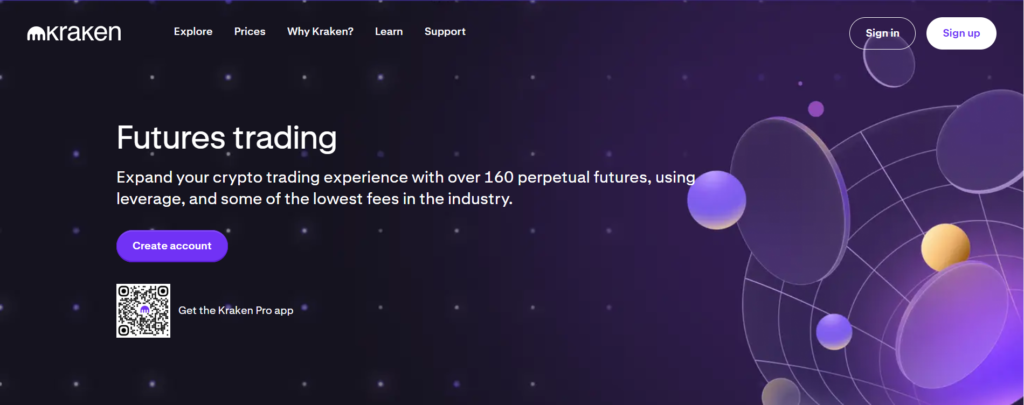
Kraken Futures, a subsidiary of the Kraken exchange, offers futures trading with a focus on security, regulatory compliance, and a wide range of assets.
Features:
- Regulatory Compliance: Operates under regulatory oversight, providing a secure trading environment.
- Variety of Contracts: Offers futures contracts for various cryptocurrencies, including Bitcoin, Ethereum, and Litecoin.
- Leverage Up to 50x: Provides leverage up to 50x, suitable for a range of trading strategies.
Fee Structure:
- Maker Fee: 0.02%
- Taker Fee: 0.05%
- Volume-Based Discounts: Lower fees for higher trading volumes.
User Experience:
- Professional Interface: Advanced trading platform with comprehensive features and tools.
- Educational Resources: Offers educational materials to help traders understand futures trading and develop strategies.
Pros:
- Strong focus on security and regulatory compliance.
- Wide range of supported assets and trading pairs.
- Educational resources for traders.
Cons:
- Higher fees compared to some competitors.
- Leverage options are more conservative.
5. BitMEX

BitMEX is known for its high-leverage trading options and innovative perpetual contracts, making it a popular choice for experienced traders.
Features:
- Perpetual Contracts: Pioneered the concept of perpetual contracts, which are widely used for Bitcoin and other major cryptocurrencies.
- High Leverage: Offers leverage up to 100x on various contracts, allowing traders to maximize their positions.
- Advanced Order Types: Includes a variety of order types, such as stop-limit, trailing stop, and hidden orders.
Fee Structure:
- Maker Fee: -0.025% (rebate)
- Taker Fee: 0.075%
- Funding Rates: Variable funding rates for perpetual contracts, based on market conditions.
User Experience:
- Professional Platform: Advanced trading interface with a focus on professional and experienced traders.
- Comprehensive Tools: Offers detailed analytics, charting tools, and market data.
Pros:
- High leverage and innovative perpetual contracts.
- Competitive fee structure with maker rebates.
- Strong analytical tools and order types.
Cons:
- Not suitable for beginners due to high leverage and complex interface.
- Regulatory concerns and legal challenges in some regions.
6. OKX
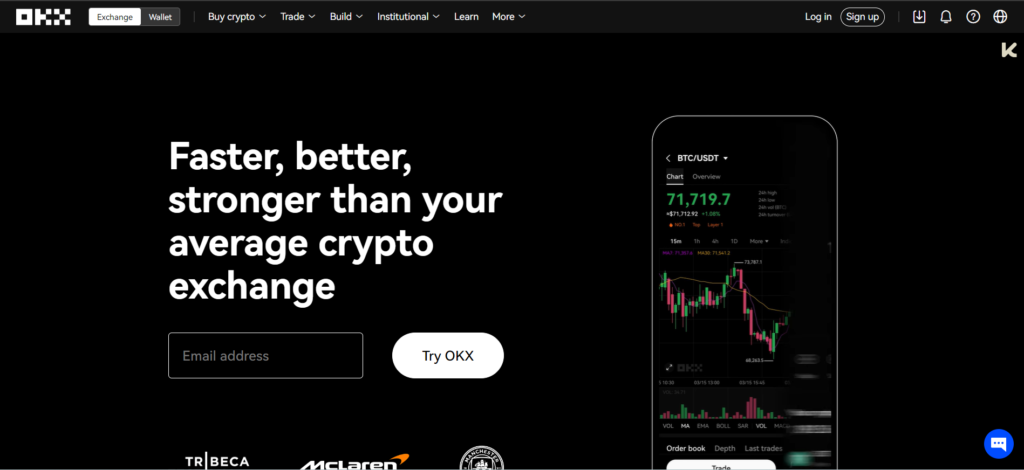
OKX is a versatile platform offering both spot and futures trading, known for its broad range of assets and advanced trading features.
Features:
- Diverse Trading Options: Provides futures contracts for various cryptocurrencies, including popular and emerging digital assets.
- Leverage Up to 125x: Allows high leverage trading, catering to both conservative and aggressive traders.
- Sophisticated Tools: Includes features like margin trading, options trading, and a comprehensive charting interface.
Fee Structure:
- Maker Fee: 0.02%
- Taker Fee: 0.05%
- Tiered Discounts: Lower fees for higher trading volumes and VIP users.
User Experience:
- Advanced Interface: User-friendly yet sophisticated platform with a range of tools for traders.
- Global Accessibility: Supports multiple languages and operates in various regions.
Pros:
- Broad range of trading options and assets.
- High leverage with flexible trading features.
- Tiered fee structure with volume discounts.
Cons:
- High leverage can be risky.
- Complex platform may have a learning curve for new users.
7. Deribit
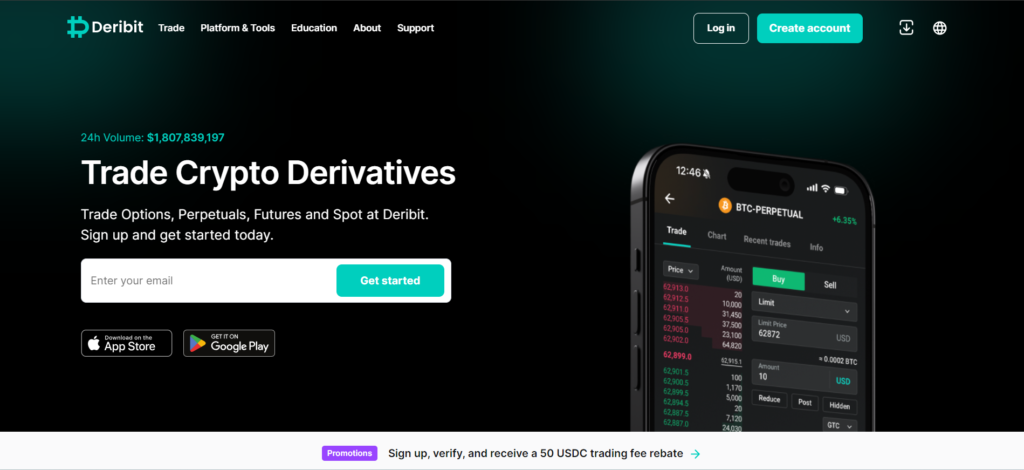
Deribit specializes in futures and options trading for Bitcoin and Ethereum, offering high leverage and a focus on professional trading tools.
Features:
- Options and Futures: Offers both options and futures contracts, providing a range of derivatives for Bitcoin and Ethereum.
- High Leverage: Allows leverage up to 100x, suitable for various trading strategies.
- Professional Tools: Includes advanced order types, analytics, and a detailed trading interface.
Fee Structure:
- Maker Fee: 0.025%
- Taker Fee: 0.05%
- Funding Rates: Variable funding rates for perpetual contracts.
User Experience:
- Professional Interface: Advanced platform designed for experienced traders and institutions.
- Educational Resources: Provides tutorials and guides to help users understand options and futures trading.
Pros:
- Specializes in Bitcoin and Ethereum derivatives.
- High leverage and advanced trading tools.
- Educational resources for traders.
Cons:
- Limited to Bitcoin and Ethereum trading.
- Less suitable for beginners due to complex interface.
Comparison of Popular Platforms
| Platform | Leverage | Key Features | Fees | Best For |
| Binance Futures | Up to 125x | Wide range of trading pairs, advanced trading tools, competitive fees, mobile app | Maker Fee: 0.02%, Taker Fee: 0.04% | Retail traders, high liquidity, diverse asset options |
| CME Group | Up to 50x | Regulated environment, institutional focus, standardized contracts | Variable based on contract | Institutional investors, regulated trading environment |
| Bybit | Up to 100x | Perpetual contracts, high leverage, user-friendly interface | Maker Fee: 0.025%, Taker Fee: 0.075% | Traders looking for high leverage and perpetual contracts |
| Kraken Futures | Up to 50x | Regulatory compliance, wide asset range, educational resources | Maker Fee: 0.02%, Taker Fee: 0.05% | Security-focused traders, educational resources |
| BitMEX | Up to 100x | Perpetual contracts, high leverage, advanced order types | Maker Fee: 0.025%, Taker Fee: 0.075% | Experienced traders, advanced trading tools |
| OKX | Up to 125x | Diverse trading options, high leverage, sophisticated tools | Maker Fee: 0.02%, Taker Fee: 0.05% | Traders seeking flexibility and a broad range of assets |
| Deribit | Up to 100x | Options and futures, high leverage, professional tools | Maker Fee: 0.025%, Taker Fee: 0.05% | Bitcoin and Ethereum derivatives traders, professional tools |
Choosing the Right Platform
When selecting a platform for crypto futures trading, consider your trading goals, risk tolerance, and preferred trading style. Here are some additional tips to help you choose the right platform:
- Security: Prioritize platforms with robust security measures, such as cold storage for funds and two-factor authentication (2FA).
- Regulation: Depending on your location and preferences, opt for platforms that comply with local regulations to ensure legal protection and operational transparency.
- User Interface: Choose a platform with an intuitive interface and advanced trading tools that align with your trading strategies.
- Customer Support: Evaluate the quality of customer support offered, including response times and availability of support channels.
- Fees: Compare fee structures, including trading fees, funding fees, and withdrawal fees, to minimize trading costs and maximize profitability.
- Liquidity: Platforms with high liquidity provide better trade execution and price stability, especially during volatile market conditions.
Tips for Successful Crypto Futures Trading
Crypto futures trading can be highly rewarding but also comes with significant risks. Implementing effective strategies and techniques is key to success. Here are essential tips to enhance your trading experience:
1. Risk Management Techniques
Managing risk is fundamental to long-term success in crypto futures trading:
- Position Sizing: Determine the appropriate size for each trade based on your risk tolerance and account size. Avoid risking more than a small percentage of your capital on any single trade.
- Stop-Loss Orders: Set stop-loss orders to automatically exit trades at predetermined price levels, limiting potential losses.
- Use of Leverage: Exercise caution when using leverage. While it can amplify gains, it also increases the risk of significant losses. Consider lower leverage ratios to mitigate risk.
2. Utilizing Technical Analysis
Technical analysis helps identify market trends and potential entry/exit points:
- Chart Patterns: Learn to recognize common chart patterns such as head and shoulders, triangles, and double tops/bottoms to anticipate price movements.
- Indicators: Use technical indicators like moving averages, RSI (Relative Strength Index), MACD (Moving Average Convergence Divergence), and Bollinger Bands to confirm trends and predict reversals.
3. Diversification Strategies
Diversifying your trading portfolio can help spread risk across different assets and strategies:
- Asset Diversification: Trade futures contracts of different cryptocurrencies to reduce exposure to any single asset’s volatility.
- Strategy Diversification: Employ a mix of trading strategies, such as trend following, scalping, and breakout trading, to adapt to different market conditions.
4. Staying Informed About Market Trends
Keeping up with market trends and developments is crucial for making informed trading decisions:
- News and Events: Stay informed about cryptocurrency news, regulatory developments, and macroeconomic events that could impact market sentiment.
- Social Media and Forums: Follow industry influencers, cryptocurrency communities, and forums to gauge market sentiment and stay updated on emerging trends.
Risks and Challenges of Trading Crypto Futures
Trading crypto futures offers substantial opportunities but also comes with inherent risks. Understanding and managing these risks are crucial for navigating the market successfully. Here are the key risks and challenges to consider:
1. High Volatility and Price Swings
Crypto markets are known for their extreme volatility, which can lead to rapid price swings:
- Market Volatility: Prices can fluctuate significantly within short periods, leading to both substantial gains and losses.
- Leverage Amplification: Trading with leverage amplifies both potential profits and losses, making it essential to use leverage cautiously.
2. Regulatory and Legal Risks
The regulatory environment for cryptocurrencies and futures trading is evolving and varies by jurisdiction:
- Legal Uncertainty: Regulatory changes or bans on crypto trading in certain regions can affect market liquidity and investor sentiment.
- Compliance Risks: Platforms may face regulatory scrutiny or legal challenges, impacting their operations and user accounts.
3. Platform Risks and Security Issues
Crypto exchanges and trading platforms are frequent targets for cyberattacks and security breaches:
- Security Vulnerabilities: Risks include hacking, phishing attacks, and theft of funds stored on centralized exchanges.
- Counterparty Risk: Trusting a third-party platform with your assets poses risks if the platform becomes insolvent or mismanages funds.
4. Psychological Challenges in Trading
Trading requires discipline and emotional resilience to withstand market fluctuations:
- Fear and Greed: Emotional reactions to market movements can lead to impulsive trading decisions.
- Risk Management Discipline: Maintaining a structured approach to risk management can mitigate emotional trading.
Conclusion: The Future of Crypto Futures Trading
As we look ahead, the future of crypto futures trading appears promising, with numerous trends and developments shaping its trajectory. Here’s an overview of the emerging trends, the integration with traditional financial markets, and the potential for innovation and growth:
Emerging Trends in Crypto Futures
The crypto futures market is evolving rapidly, driven by technological advancements, increasing institutional interest, and evolving regulatory landscapes:
- Decentralized Finance (DeFi) Integration: DeFi protocols are gaining traction, allowing for decentralized trading of crypto derivatives, which could enhance transparency and reduce counterparty risks.
- Stablecoin Futures: The introduction of stablecoin futures contracts is gaining momentum, providing a hedge against volatility while offering a stable trading environment.
- Increased Institutional Participation: More institutional investors are entering the crypto market, seeking to hedge against traditional market risks and explore new investment opportunities in crypto futures.
Integration with Traditional Financial Markets
The convergence of crypto futures with traditional financial markets is accelerating, offering new opportunities for traders and investors:
- Regulatory Harmonization: Efforts to harmonize regulations between traditional finance and cryptocurrencies are underway, enhancing market integrity and investor confidence.
- Institutional Products and Services: Traditional financial institutions are increasingly offering crypto futures products, providing sophisticated trading tools and services tailored to institutional clients.
- Market Infrastructure Development: Advancements in market infrastructure, including custody solutions, clearinghouses, and compliance technologies, are enhancing the security and efficiency of crypto futures trading.
Potential for Innovation and Growth
The potential for innovation in the crypto futures market is vast, with several areas poised for significant growth:
- Advanced Trading Technologies: Innovations in AI, machine learning, and algorithmic trading are expected to enhance trading strategies, improve market predictions, and optimize risk management.
- Cross-Asset Trading Platforms: Platforms that enable trading across different asset classes, including traditional assets and cryptocurrencies, are likely to emerge, offering more diverse trading opportunities.
- Sustainable and Green Finance: The integration of sustainable finance practices into crypto futures trading, such as carbon offsetting and green investment funds, could become a focal point for the industry.
Conclusion
The future of crypto futures trading is characterized by innovation, increased institutional involvement, and deeper integration with traditional financial markets. As the industry matures, regulatory frameworks will likely evolve to support growth while protecting investors. Traders and investors who stay abreast of these trends, embrace new technologies, and adopt robust risk management practices will be well-positioned to thrive in this dynamic market.
FAQs
What are crypto futures?
Crypto futures are financial contracts that obligate traders to buy or sell a specified cryptocurrency at a predetermined price and time in the future. These contracts allow traders to speculate on the future price movements of cryptocurrencies without owning the underlying assets.
How does leverage work in crypto futures trading?
Leverage allows traders to amplify their exposure to the market by borrowing funds from the exchange. For example, with 10x leverage, a trader can control a position size ten times larger than their initial capital. While leverage can amplify profits, it also increases the risk of losses.
What are the advantages of trading crypto futures?
Some advantages of trading crypto futures include:
- Risk Management: Futures contracts allow traders to hedge against price fluctuations, reducing overall market risk.
- Liquidity: Crypto futures markets often have high liquidity, ensuring efficient trade execution even during volatile market conditions.
- Diverse Trading Opportunities: Traders can profit from both rising (long positions) and falling (short positions) cryptocurrency prices.
What factors should I consider before trading crypto futures?
Before trading crypto futures, consider factors such as:
- Risk Tolerance: Assess how much risk you are willing to take on, considering the high volatility of cryptocurrencies.
- Market Research: Conduct thorough research on the cryptocurrency market, including technical analysis and fundamental factors influencing prices.
- Platform Selection: Choose a reputable and secure trading platform that offers the features and tools aligned with your trading strategy.
What are the risks associated with crypto futures trading?
Risks associated with crypto futures trading include:
- Volatility: Crypto markets are highly volatile, leading to rapid price fluctuations and potential for significant losses.
- Regulatory Uncertainty: Regulatory changes or bans on cryptocurrencies in certain jurisdictions can impact market sentiment and liquidity.
- Security Risks: Exchanges and trading platforms may be vulnerable to hacking or security breaches, resulting in the loss of funds.


